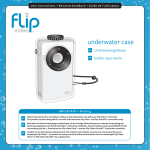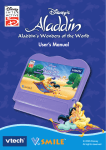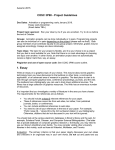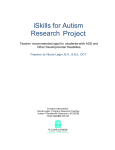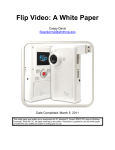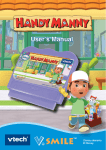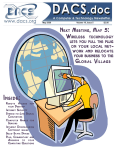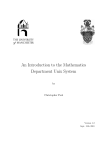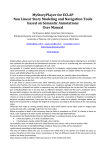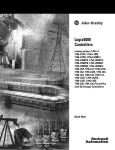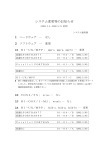Download Flip Video: A White Paper Amy Womble November 2, 2008
Transcript
Flip Video: A White Paper Amy Womble November 2, 2008 This white paper was written as an assignment for Dr. Marshall G. Jones's EDUC 651 class at Winthrop University, Rock Hill, SC. All rights reserved by the author. Permission is granted to use this white paper provided the user notifies the author in writing prior to use. Womble © 2008 Page 1 of 7 What it is Flip digital camcorders, made by Pure Digital Technologies, allow users to record up to 60 minutes of video with the push of a button. There is a USB drive that flips out so that it can be plugged directly into a computer’s port for viewing, editing, or sharing. Flip camcorders also come with a TV connector so that videos can be shown on TV. The camcorder includes software to view, create, and share custom movies with music. Where to find it Flip camcorders can be bought online at the official Flip store http://www.theflip.com/store/. They can also be found in retailers nationwide such as Wal-Mart and Best Buy. For a complete list or retailers, visit http://www.theflip.com/buy/. Prices for Flip camcorders vary depending on the model. Flip Video, the original in the series, retails at $130. The Ultra goes for $150 and the Mino retails for $180. If you choose to get a version with only 30 minutes of recording time, the price is under $100. Pure Digital Technologies offers educators a discount on their online store. With proof of employment at a school, you receive $15.00 off each camcorder if you buy at least 3. How to use it Figure 1 The Flip video camcorder’s display panel. (http://g-ec2.imagesamazon.com/images/G/01/photo/detailpages/flip.diagram.orange.jpg) The Flip is designed to be simple to operate. To turn it on, press the power button. Then, just press the red button to record. The camcorder does not come with a wide range of functions like other camcorders. Still, users can use the up or down arrows on the device to zoom in or out (the camera has a 2x digital zoom). These same arrow buttons are used Womble © 2008 Page 2 of 7 to turn the volume up or down when in playback mode. To get to this mode, simply press the play button and you can scroll through the videos you’ve captured. Once you’ve captured video on the camcorder, flip out the USB arm and plug it directly into your computer. Each camcorder comes preloaded with the Flip Video program. The camera will automatically check your computer for Flip software and install it if needed. With this program, you can watch videos and capture still photos from your videos. There is a “Create a Movie” option, but it is a little misleading. You can’t add music, titles or cut and paste your movies here. For those things, you’ll need a program such as Windows Movie Maker or iMovie. The “Create a Movie” option on the Flip Video program only lets you join all of the video clips to create one longer movie. The Flip Video software also allows you to send your videos to Pure Digital Technologies and have a DVD made and mailed to you for less than $20. You could also do this by taking the camcorder to a local Pure Digital retailer for processing. In addition, users can easily share videos on YouTube or MySpace by clicking on the links available on the Flip software. Figure 2 Three steps to using and sharing the Flip. (http://www.theflip.com/products_try.shtml) Womble © 2008 Page 3 of 7 Specifications Flip Mino Flip Ultra Flip Video Recording Time 60 minutes 60 minutes 60 minutes Internal Memory 2 GB 2 GB 1 GB Screen Size LCD screen Resolution Video Resolution Pause, FF/Rewind 1.5” diagonal 1.5” diagonal 1.5” diagonal 528 x 132 280 x 120 280 x 120 640 x 480 Yes 640 x 480 No 640 x 480 No Frames per second 30 30 30 Set Time/Date Yes Yes No Educational Implications Reading Fluency- In the primary classroom, reading fluency is a critical objective. Students often practice reading familiar text to improve reading speed and expression. Reader’s Theater is a program implemented in many classrooms in which students perform a skit using scripts that are read, not memorized. One of the most critical parts of Reader’s Theater is the evaluation that peers give to the performers. The Flip would allow teachers to record student performance, immediately show the performance on television or the computer and gain feedback from students on their reading fluency. This would also allow for students in other classrooms, or even across the country to give feedback to readers. Students could upload videos and email them to other groups of students for review. Virtual Field Trips- For some students, field trips are a luxury. The Flip could serve as a valuable tool for educators and students in giving access to real world examples of concepts learned in the classroom. For example, a teacher making a trip to a zoo could record up to an hour of short clips giving information and showing animals in their habitat. This would be much more effective than simply reading a book or telling students about animals. Upper elementary students could take the research into their own hands and record their own video diary of an experience that correlates with the curriculum. Assessment- Teachers are always looking for authentic assessments to ensure students have mastered the required objectives. Instead of a report or test to assess student understanding of a concept, students could create a video report. These could be shared on the class website or presented to the class using the TV adapter cable. Womble © 2008 Page 4 of 7 Student creativity- No matter the assignment, students will be able to use their creativity and feel a sense of ownership with the final product. Even the youngest students can create a simple movie to be proud of. National Education Technology Standards (NETS) Creativity and Innovation- Students demonstrate creative thinking, construct knowledge, and develop innovative products and processes using technology. Students: a. apply existing knowledge to generate new ideas, products, or processes. b. create original works as a means of personal or group expression. The Flip can be used as an assessment tool. Students can use it to create final projects for a unit and demonstrate their knowledge by generating new ideas. For example, after learning about different types of clouds in a science unit, students could use this piece of technology to create a video in which they identify clouds as cirrus, nimbus, stratus or cumulus. In a Social Studies unit on citizenship and elections, students could create a campaign ad as a group. This allows not only for using technology, but for expression and creativity. Even primary students can use their creativity to edit a video in Windows Movie Maker or iMovie. Communication and Collaboration-Students use digital media and environments to communicate and work collaboratively, including at a distance, to support individual learning and contribute to the learning of others. Students: a. interact, collaborate, and publish with peers, experts, or others employing a variety of digital environments and media. b. communicate information and ideas effectively to multiple audiences using a variety of media and formats. Students can use the Flip to create video reports on topics learned in class. Older students could use the camera to capture information on a field trip and share this information with their peers. Group videos could be posted on the class website to communicate information to a variety of audiences that students may not otherwise be able to reach. Technology Operations and Concepts Students demonstrate a sound understanding of technology concepts, systems, and operations. Students: a. understand and use technology systems. b. select and use applications effectively and productively. Using the Flip camera and movie editing software such as Windows Movie Maker or iMovie, students can explore a variety of technologies. This technology would serve as a tool for students to use and express ideas or create projects while demonstrating that they understand how to operate digital video technology. Womble © 2008 Page 5 of 7 Environmental Factors to Consider Zoom- The Flip only offers a 2X digital zoom. Therefore, users must be in close proximity to the subject they are filming for the best picture. Lighting- There is not a light on the Flip camera, so users need to shoot in a well lit area for best results. Access to Editing Software – Since the software preloaded on the Flip doesn’t offer much in the way of editing, it’s best to have access to a movie editing program such as Windows Movie Maker of iMovie. Otherwise, users will only be able to produce a movie with clips in the order in which they were recorded. USB Accessibility-For some CPUs, there isn’t enough side clearance on the CPU’s female port to allow the USB attachment to fit. The same is true for many laptops. In many cases, users may need to buy the USB attachment cable which costs an additional $15. Benefits Ease of Use- The Flip could not be simpler to use. Students and teachers alike can operate it without touching a user’s manual. The viewing and sharing software that comes with the Flip is equally as user-friendly. Virtually Indestructible-- The Flip doesn’t have any particularly fragile parts. It is kidfriendly in the fact that it could be dropped on most surfaces and remain intact. The USB arm is the somewhat fragile, but it snaps into the side of the camera and out of harm’s way. Portable- This camera is only a bit larger than most cell phones and weighs less than 5.5 ounces. It can easily fit into a pocket, purse or book bag. This allows for the Flip to travel anywhere and capture events quickly without the hassle of carrying around a larger, heavier camcorder. Drawbacks Small Screen- The LCD screen is only 1.5inches diagonally. This may cause a problem for users who are visually impaired. No Tapes or Discs- Not having tapes or discs to carry around may be a benefit, but it also means that when the memory is full, you have to download the videos to a computer to Womble © 2008 Page 6 of 7 free up the internal memory. This may be an inconvenience if you are traveling or don’t have access to a computer. Behavior Issues- Particularly with younger students, behavior issues may arise once the recording begins. Clear procedures would need to be established beforehand to prevent students from forgetting the task at hand and becoming silly for the camera. Resources Official Flip Video Website http://www.theflip.com/products_flip_ultra.shtml NY Times Article on Flip Video http://www.nytimes.com/2008/03/20/technology/personaltech/20pogue.html?_r=1&oref= slogin Links You Tube www.youtube.com iMovie Information www.apple.com/ilife/imovie/ How to Use Windows Movie Maker www.microsoft.com/windowsxp/using/moviemaker/default.mspx Womble © 2008 Page 7 of 7








